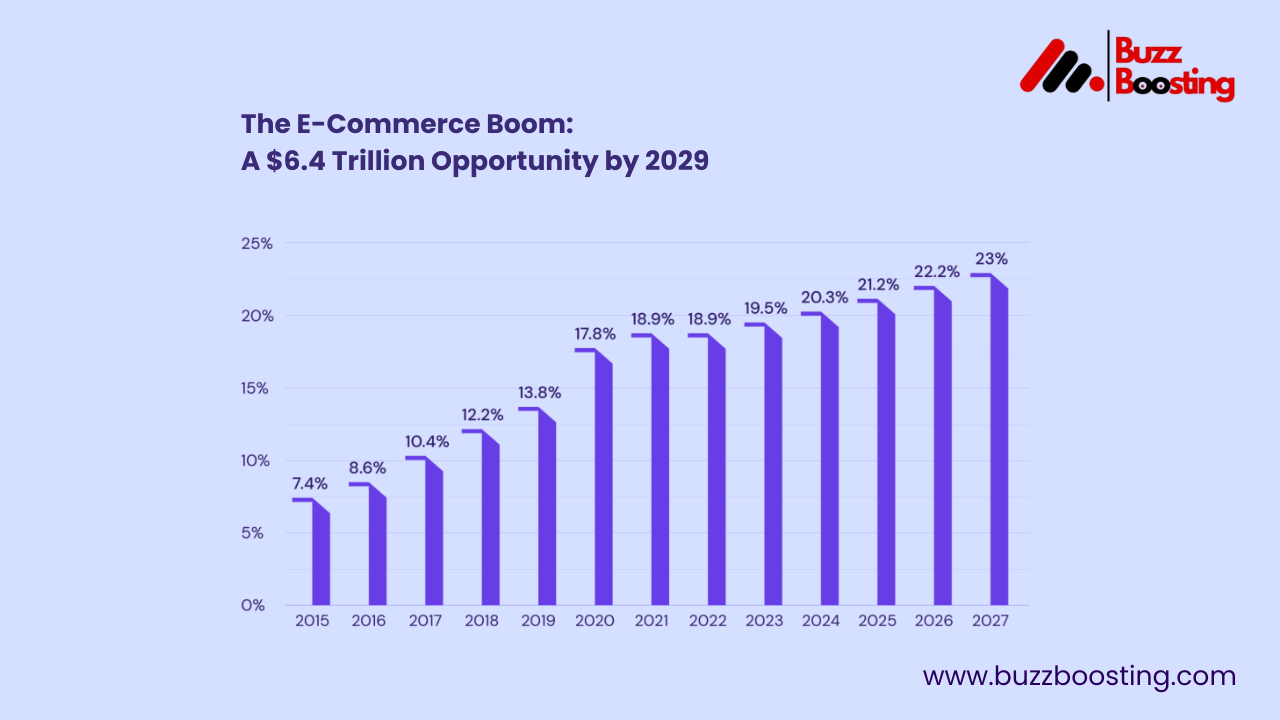Online shopping isn’t just convenient anymore—it’s a lifestyle. From last-minute groceries to big-ticket tech, people are embracing the digital marketplace like never before. Global e-commerce sales are expected to hit an astonishing $6.4 trillion by 2029, and behind this number lies a web of innovation, user behavior shifts, and digital transformation.
A Paradigm Shift in How We Buy
The last decade ushered in a digital revolution, but the past few years have accelerated e-commerce to warp speed. While global crises pushed consumers online, the seamless experiences, smarter personalization, and speed of service kept them there. Today, shopping online isn’t a choice—it’s the norm.
As digital habits become more ingrained, businesses are reimagining customer journeys from the ground up. For local brands, tech startups, and global giants alike, it’s an exciting—and essential—time to evolve.
What’s Fueling the Growth?
1. Pocket Power: The Mobile Movement
With over 70% of e-commerce traffic coming from smartphones, mobile-first design isn’t optional—it’s the rule. Brands that offer fast-loading, intuitive mobile shopping experiences win both clicks and loyalty.
2. Social Media as the New Mall
Instagram Reels. TikTok Lives. Pinterest Pins. Social commerce blends storytelling and shopping into one scrollable stream. This isn’t window shopping—this is spontaneous, emotionally-driven buying that feels fun and frictionless.
3. AI Knows You Better Than You Know Yourself
E-commerce is no longer one-size-fits-all. AI-driven recommendations, smart chatbots, and personalized email offers create tailor-made experiences, increasing the chances of “I need this” purchases.
4. Boundaries? What Boundaries?
Cross-border commerce is booming. With translation tools, international payment gateways, and global fulfillment centers, even a small local brand can serve customers worldwide. For example, agencies offering website development in Patna are now building global platforms that compete with the best.
5. Seamless Payments, Every Time
From BNPL (Buy Now, Pay Later) to crypto and digital wallets, customers now expect checkout options that fit their lifestyles. Less friction at checkout equals fewer abandoned carts.
Industries Riding the E-Commerce Wave
This digital tide is sweeping across sectors, reshaping how industries operate:
- Fashion & Beauty: Virtual try-ons and AI stylists offer an in-store vibe, from the couch.
- Food & Groceries: Weekly staples, delivered in hours. Welcome to the subscription grocery model.
- Healthcare: Telehealth, online consultations, and home-delivered meds are now mainstream.
- Luxury: High-end brands are embracing VR showrooms and blockchain-verified products.
The Flip Side: What Challenges Lie Ahead?
No growth story is without friction. E-commerce’s rise brings its own set of issues:
- Data Privacy: As personalization improves, so does the need for ethical data usage. Consumers demand transparency, and governments are responding with stricter laws.
- Environmental Concerns: More packages = more carbon footprint. Brands are racing to meet eco-expectations through greener shipping and sustainable packaging.
- Delivery Pains: Fast shipping isn’t easy, especially in remote or over-saturated markets. Innovations like drone drops and micro-warehouses may soon offer relief.
How Brands Can Prepare
In this fast-moving world, what separates thriving brands from forgotten ones? Agility. Here’s how to stay in the game:
1. Go Omnichannel
Whether it’s online, in-app, or in-store, customers expect a smooth, consistent experience. Integrate channels, don’t compete them.
2. Prioritize User Experience
From page speed to checkout flow, simplicity is king. And yes, make it mobile-optimized—always.
3. Be Data-Smart, Not Data-Greedy
Use analytics to tailor experiences, but always with customer consent and clarity. Respect builds trust.
4. Community is Currency
People don’t just buy products—they join movements. Encourage reviews, foster forums, and co-create with users. Engagement turns casual shoppers into brand evangelists.
5. Stay Light on Your Feet
Tech shifts fast. What works today may be outdated in six months. Experiment, analyze, and adapt.
The Local Angle: E-Commerce in Smaller Cities
As digital infrastructure spreads, smaller cities like Patna are becoming hotbeds of online business growth. Entrepreneurs are turning to website development in Patna to create sleek, conversion-focused platforms that serve both local and international audiences. These websites are helping small businesses scale up, reach new customers, and plug into the global e-commerce engine.
The Future is Fluid—and Bright
By 2029, $6.4 trillion in e-commerce sales isn’t just about more transactions—it’s about better ones. Personalized, ethical, fast, and delightful. Whether you’re a seller in Seoul, a shopper in San Francisco, or a developer in Patna, the digital retail space is full of possibilities.
As brands innovate and consumers evolve, e-commerce will become less of a “channel” and more of a lifestyle ecosystem. And those who understand this shift—who embrace tech, prioritize people, and adapt with authenticity—will ride the wave to remarkable success.





